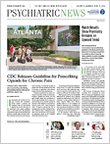APA has a diverse membership, and our members have a variety of perspectives about U.S. gun policy and imposing restrictions on gun ownership. I would argue that no matter what our individual political beliefs are, we should be united on restricting access to guns as a public health strategy to prevent suicide. As psychiatrists, we deal with patients who are suicidal, and one of our professional duties is to try and prevent those patients from self-harm, whenever possible. Asking about gun ownership and educating families about the risks of having guns in the home are important steps in preventing suicide. In this column, I will review some of the data about the relationship between gun ownership and suicide and strategies that we can take to decrease suicide by guns.
Relationship Between Suicide, Gun Ownership
When we talk about overall gun violence in the United States, we need to realize that most deaths from firearm violence are actually suicides and not homicides. In fact, more than 60 percent of all firearm deaths are suicides. Although there are many ways of trying to commit self-harm, attempting suicide with guns is lethal 85 percent of the time, and over 50 percent of completed suicides involve firearms. Therefore, it is important to decrease the availability of guns to individuals who are at risk for making suicide attempts.
The rate at which Americans commit suicide with guns is generally correlated with higher gun ownership. Studies in the United States have shown that some states with more restrictive gun permits and licensing requirements have lowered suicide rates. For example, suicide rates fell in Connecticut after a law was passed in 1995 requiring licensing. Suicide rates increased in Missouri after it repealed a similar law in 2007. In Washington, D.C., a handgun ban was followed by an abrupt decline (6 per month, or 23 percent) in suicide by firearms. No similar reductions were seen in suicides by other means, and no reductions were seen in neighboring jurisdictions that were not subject to the law.
This seems to be true in other countries also. A study in Switzerland showed a decrease in suicide rates after a reform was instituted that decreased the number of firearms available in the homes of military reserve personnel. In Australia, access to firearms was restricted in 1997 after a shooting rampage, and fatal suicides from guns decreased nearly 80 percent. In Israel, the military cut the suicide rate among soldiers by 40 percent by forbidding them to take their service weapons home on weekends. Before the new policy, 90 percent of the suicides by soldiers occurred with firearms and often when the soldiers were on leave.
Adolescent Suicide and Access to Guns
Suicide is the second leading cause of death among adolescents. About 40 percent of teen suicides are committed with firearms—typically those of their parents.
About one-third of homes in the United States have a gun, and about half of all handgun owners keep their guns loaded at least some of the time. In addition, 40 percent of gun owners store guns in a bedroom or closet, rather than in a locked case, cabinet, or vault. Thus, when adolescents are contemplating suicide, they often have easy access to loaded guns.
Does Restricting Access to Guns Decrease Suicide Rates?
The argument could be made that if individuals are intent on committing suicide and a gun is not available, they will use another means to commit suicide. However, evidence from other countries that decreased the availability of certain methods of suicide suggests that this is not the case. If people do not have access to one method of suicide, they do not necessarily choose a different method.
For example, in Great Britain, people used to kill themselves by putting their heads in the oven and asphyxiating themselves with coal gas. This accounted for almost half of British suicides in the late 1950s. Subsequently, Britain began switching from coal gas to natural gas, which is much less lethal. The overall suicide rates in England and Wales went down because coal-burning suicides were going down. Other means of suicide stayed the same.
Similarly, in Sri Lanka in the early 1990s, suicide rates were among the highest in the world, and one of the preferred methods was by poisoning with pesticides. When Sri Lanka decreased the use of pesticides, its rate of suicide declined by 50 percent over a 10-year period. This decrease was mainly due to the decrease of pesticide-related deaths while other types of suicides remained the same.
Therefore, the experience of what happened when the availability of coal gas and pesticides decreased suggests that suicidal people wanting to use guns to kill themselves will not necessarily find another method to kill themselves if they don’t have access to guns. Suicidal acts are often impulsive: 1 in 4 people who attempted suicide said it was less than 5 minutes between their decision to attempt and act. Fewer than 10 percent of suicide survivors go on to subsequently commit suicide.
Prevention Strategies
•
The first strategy is to decrease access to guns for people who are suicidal. As psychiatrists, we can do this by always asking about patients’ access to guns as part of a suicide risk assessment. We should strongly recommend to patients who have a gun in the home that the gun be removed as a safety precaution. In California, if individuals are placed on a 72-hour involuntary hold as a danger to themselves, they are prohibited from purchasing or possessing guns for five years. This policy should be expanded to other states.
•
It is important to educate families about the risks of having firearms in the home, especially when there are adolescents and children. This is to prevent accidental gun deaths and to prevent adolescents or their friends from having easy access to guns in case of suicidal ideation. When a gun is stored safely, the risk of suicide is decreased. We need to encourage the use of gunlocks, lock boxes, and separate storage of guns and ammunition.
•
We need to lobby against gag laws that prohibit asking patients about guns. Meanwhile, we need to understand that even the most restrictive gag orders don’t prohibit physicians from asking about guns when clinically relevant.
The 2015 Florida statute states: “A health care practitioner … shall respect a patient’s right to privacy and should refrain from making a written inquiry or asking questions concerning the ownership of a firearm or ammunition by the patient or by a family member of the patient, or the presence of a firearm in a private home or other domicile of the patient or a family member of the patient. Notwithstanding this provision, a health care practitioner or health care facility that in good faith believes that this information is relevant to the patient’s medical care or safety, or the safety of others, may make such a verbal or written inquiry.”
As described in this column, inquiring and educating about guns is clearly relevant to our patients and their families’ medical care and safety. ■

